Strategies to Promote Public Transport Use: An Essay
VerifiedAdded on 2023/01/17
|8
|2127
|74
Essay
AI Summary
This essay delves into the critical issue of promoting public transport to alleviate infrastructure strain caused by increased urbanization and private vehicle usage. It examines various strategies to encourage public transport adoption, starting with governmental actions such as providing adequate transport means and funding for environmental and social reasons. The essay emphasizes the importance of fare reductions, particularly for minority groups, and well-managed, clean services with recognizable branding. It also highlights the need for convenient station locations, reliable and swift services, and increased costs for private travel. Furthermore, the essay stresses the role of public campaigns, system integration, smart ticketing, and strong leadership in making public transport a more effective option. It concludes by advocating for policy changes, technological advancements, and overall awareness to facilitate a shift towards public transportation.
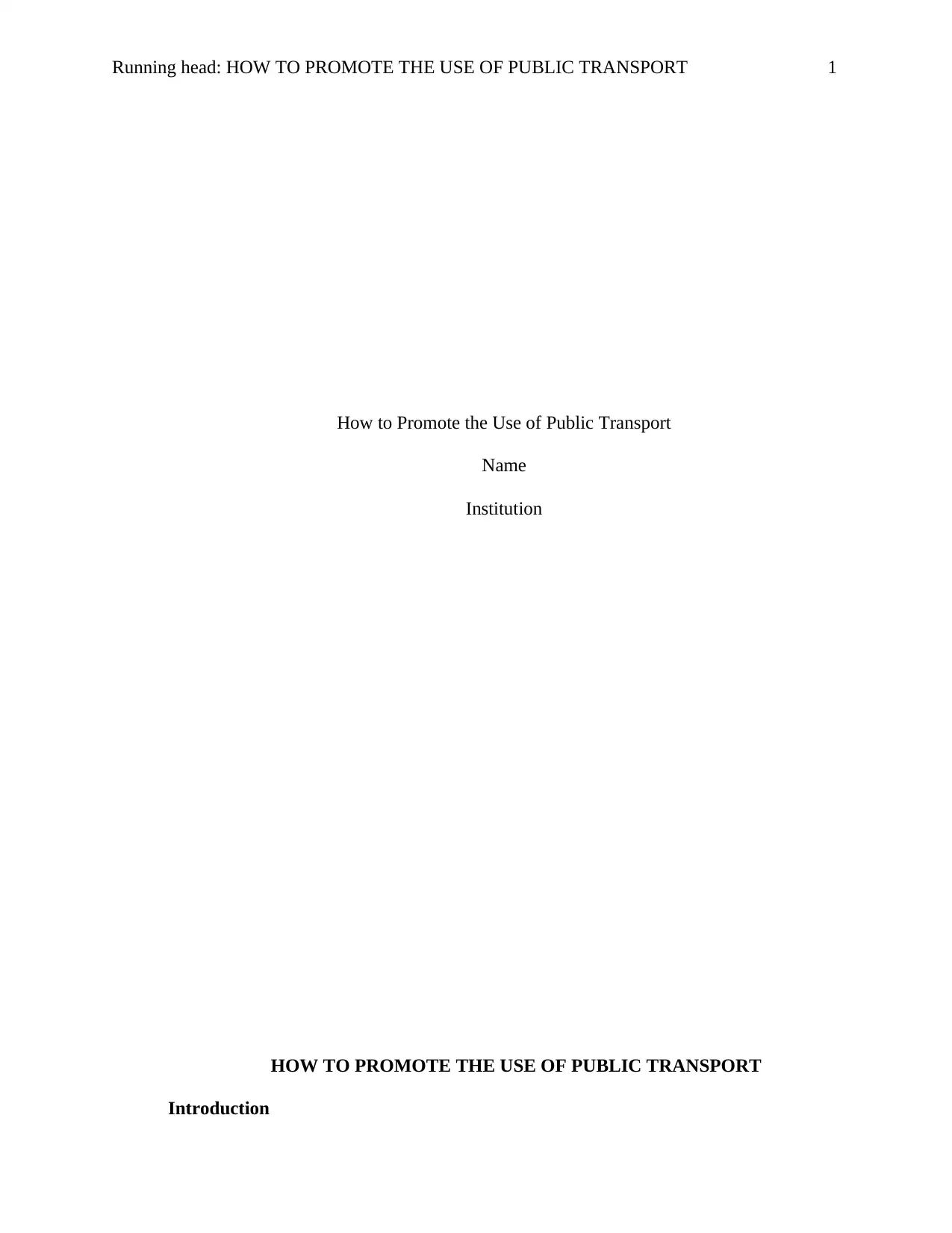
Running head: HOW TO PROMOTE THE USE OF PUBLIC TRANSPORT 1
How to Promote the Use of Public Transport
Name
Institution
HOW TO PROMOTE THE USE OF PUBLIC TRANSPORT
Introduction
How to Promote the Use of Public Transport
Name
Institution
HOW TO PROMOTE THE USE OF PUBLIC TRANSPORT
Introduction
Paraphrase This Document
Need a fresh take? Get an instant paraphrase of this document with our AI Paraphraser
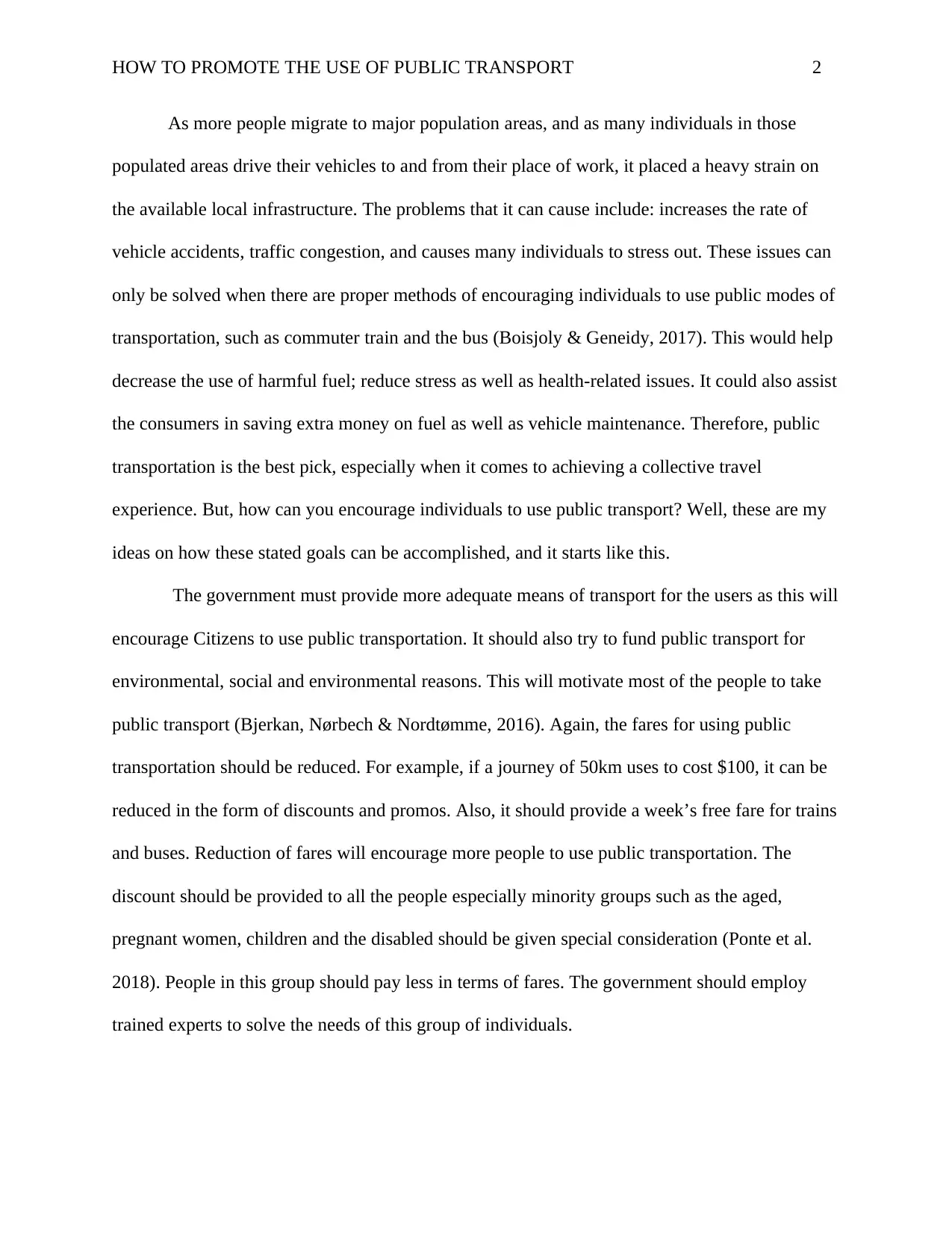
HOW TO PROMOTE THE USE OF PUBLIC TRANSPORT 2
As more people migrate to major population areas, and as many individuals in those
populated areas drive their vehicles to and from their place of work, it placed a heavy strain on
the available local infrastructure. The problems that it can cause include: increases the rate of
vehicle accidents, traffic congestion, and causes many individuals to stress out. These issues can
only be solved when there are proper methods of encouraging individuals to use public modes of
transportation, such as commuter train and the bus (Boisjoly & Geneidy, 2017). This would help
decrease the use of harmful fuel; reduce stress as well as health-related issues. It could also assist
the consumers in saving extra money on fuel as well as vehicle maintenance. Therefore, public
transportation is the best pick, especially when it comes to achieving a collective travel
experience. But, how can you encourage individuals to use public transport? Well, these are my
ideas on how these stated goals can be accomplished, and it starts like this.
The government must provide more adequate means of transport for the users as this will
encourage Citizens to use public transportation. It should also try to fund public transport for
environmental, social and environmental reasons. This will motivate most of the people to take
public transport (Bjerkan, Nørbech & Nordtømme, 2016). Again, the fares for using public
transportation should be reduced. For example, if a journey of 50km uses to cost $100, it can be
reduced in the form of discounts and promos. Also, it should provide a week’s free fare for trains
and buses. Reduction of fares will encourage more people to use public transportation. The
discount should be provided to all the people especially minority groups such as the aged,
pregnant women, children and the disabled should be given special consideration (Ponte et al.
2018). People in this group should pay less in terms of fares. The government should employ
trained experts to solve the needs of this group of individuals.
As more people migrate to major population areas, and as many individuals in those
populated areas drive their vehicles to and from their place of work, it placed a heavy strain on
the available local infrastructure. The problems that it can cause include: increases the rate of
vehicle accidents, traffic congestion, and causes many individuals to stress out. These issues can
only be solved when there are proper methods of encouraging individuals to use public modes of
transportation, such as commuter train and the bus (Boisjoly & Geneidy, 2017). This would help
decrease the use of harmful fuel; reduce stress as well as health-related issues. It could also assist
the consumers in saving extra money on fuel as well as vehicle maintenance. Therefore, public
transportation is the best pick, especially when it comes to achieving a collective travel
experience. But, how can you encourage individuals to use public transport? Well, these are my
ideas on how these stated goals can be accomplished, and it starts like this.
The government must provide more adequate means of transport for the users as this will
encourage Citizens to use public transportation. It should also try to fund public transport for
environmental, social and environmental reasons. This will motivate most of the people to take
public transport (Bjerkan, Nørbech & Nordtømme, 2016). Again, the fares for using public
transportation should be reduced. For example, if a journey of 50km uses to cost $100, it can be
reduced in the form of discounts and promos. Also, it should provide a week’s free fare for trains
and buses. Reduction of fares will encourage more people to use public transportation. The
discount should be provided to all the people especially minority groups such as the aged,
pregnant women, children and the disabled should be given special consideration (Ponte et al.
2018). People in this group should pay less in terms of fares. The government should employ
trained experts to solve the needs of this group of individuals.
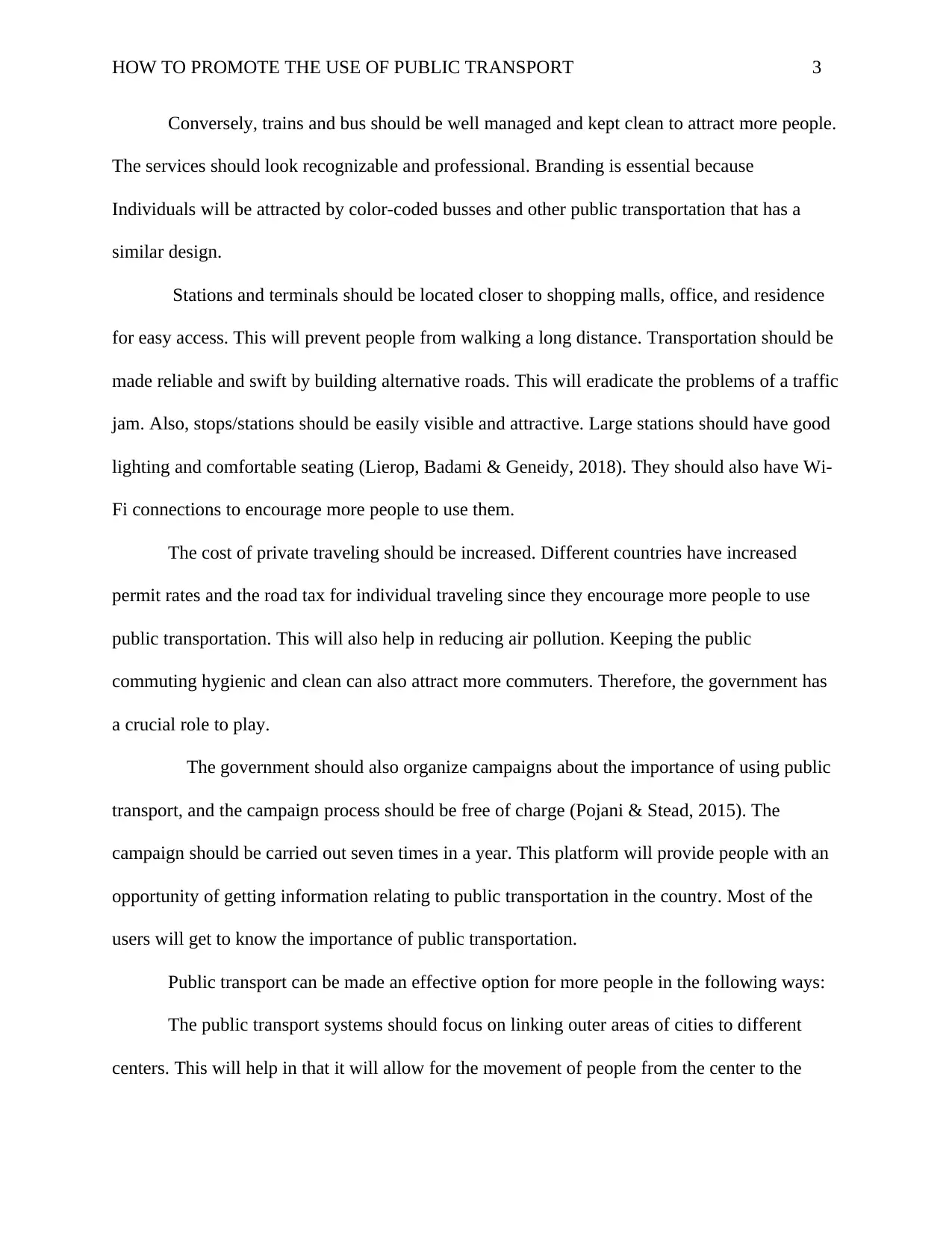
HOW TO PROMOTE THE USE OF PUBLIC TRANSPORT 3
Conversely, trains and bus should be well managed and kept clean to attract more people.
The services should look recognizable and professional. Branding is essential because
Individuals will be attracted by color-coded busses and other public transportation that has a
similar design.
Stations and terminals should be located closer to shopping malls, office, and residence
for easy access. This will prevent people from walking a long distance. Transportation should be
made reliable and swift by building alternative roads. This will eradicate the problems of a traffic
jam. Also, stops/stations should be easily visible and attractive. Large stations should have good
lighting and comfortable seating (Lierop, Badami & Geneidy, 2018). They should also have Wi-
Fi connections to encourage more people to use them.
The cost of private traveling should be increased. Different countries have increased
permit rates and the road tax for individual traveling since they encourage more people to use
public transportation. This will also help in reducing air pollution. Keeping the public
commuting hygienic and clean can also attract more commuters. Therefore, the government has
a crucial role to play.
The government should also organize campaigns about the importance of using public
transport, and the campaign process should be free of charge (Pojani & Stead, 2015). The
campaign should be carried out seven times in a year. This platform will provide people with an
opportunity of getting information relating to public transportation in the country. Most of the
users will get to know the importance of public transportation.
Public transport can be made an effective option for more people in the following ways:
The public transport systems should focus on linking outer areas of cities to different
centers. This will help in that it will allow for the movement of people from the center to the
Conversely, trains and bus should be well managed and kept clean to attract more people.
The services should look recognizable and professional. Branding is essential because
Individuals will be attracted by color-coded busses and other public transportation that has a
similar design.
Stations and terminals should be located closer to shopping malls, office, and residence
for easy access. This will prevent people from walking a long distance. Transportation should be
made reliable and swift by building alternative roads. This will eradicate the problems of a traffic
jam. Also, stops/stations should be easily visible and attractive. Large stations should have good
lighting and comfortable seating (Lierop, Badami & Geneidy, 2018). They should also have Wi-
Fi connections to encourage more people to use them.
The cost of private traveling should be increased. Different countries have increased
permit rates and the road tax for individual traveling since they encourage more people to use
public transportation. This will also help in reducing air pollution. Keeping the public
commuting hygienic and clean can also attract more commuters. Therefore, the government has
a crucial role to play.
The government should also organize campaigns about the importance of using public
transport, and the campaign process should be free of charge (Pojani & Stead, 2015). The
campaign should be carried out seven times in a year. This platform will provide people with an
opportunity of getting information relating to public transportation in the country. Most of the
users will get to know the importance of public transportation.
Public transport can be made an effective option for more people in the following ways:
The public transport systems should focus on linking outer areas of cities to different
centers. This will help in that it will allow for the movement of people from the center to the
⊘ This is a preview!⊘
Do you want full access?
Subscribe today to unlock all pages.

Trusted by 1+ million students worldwide
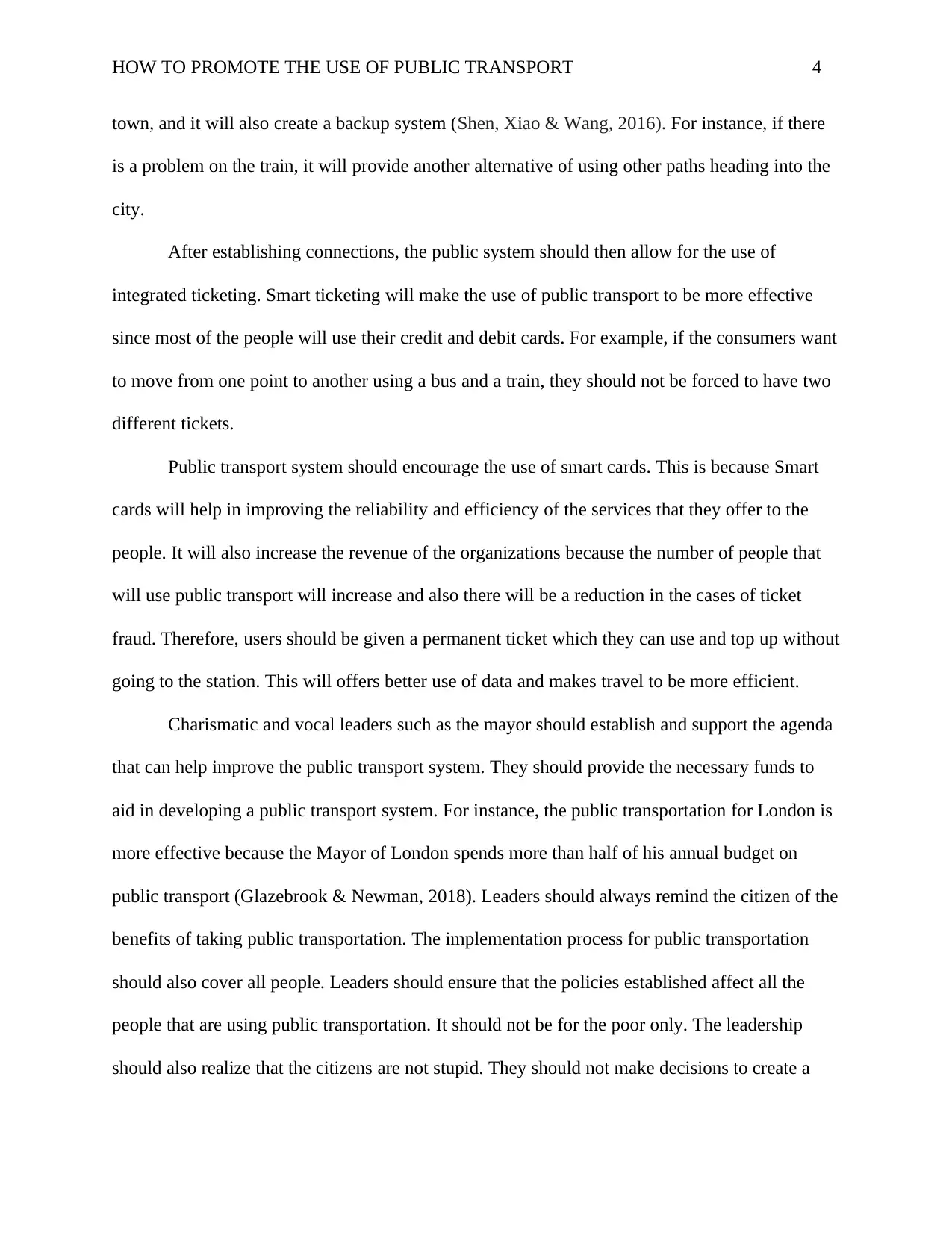
HOW TO PROMOTE THE USE OF PUBLIC TRANSPORT 4
town, and it will also create a backup system (Shen, Xiao & Wang, 2016). For instance, if there
is a problem on the train, it will provide another alternative of using other paths heading into the
city.
After establishing connections, the public system should then allow for the use of
integrated ticketing. Smart ticketing will make the use of public transport to be more effective
since most of the people will use their credit and debit cards. For example, if the consumers want
to move from one point to another using a bus and a train, they should not be forced to have two
different tickets.
Public transport system should encourage the use of smart cards. This is because Smart
cards will help in improving the reliability and efficiency of the services that they offer to the
people. It will also increase the revenue of the organizations because the number of people that
will use public transport will increase and also there will be a reduction in the cases of ticket
fraud. Therefore, users should be given a permanent ticket which they can use and top up without
going to the station. This will offers better use of data and makes travel to be more efficient.
Charismatic and vocal leaders such as the mayor should establish and support the agenda
that can help improve the public transport system. They should provide the necessary funds to
aid in developing a public transport system. For instance, the public transportation for London is
more effective because the Mayor of London spends more than half of his annual budget on
public transport (Glazebrook & Newman, 2018). Leaders should always remind the citizen of the
benefits of taking public transportation. The implementation process for public transportation
should also cover all people. Leaders should ensure that the policies established affect all the
people that are using public transportation. It should not be for the poor only. The leadership
should also realize that the citizens are not stupid. They should not make decisions to create a
town, and it will also create a backup system (Shen, Xiao & Wang, 2016). For instance, if there
is a problem on the train, it will provide another alternative of using other paths heading into the
city.
After establishing connections, the public system should then allow for the use of
integrated ticketing. Smart ticketing will make the use of public transport to be more effective
since most of the people will use their credit and debit cards. For example, if the consumers want
to move from one point to another using a bus and a train, they should not be forced to have two
different tickets.
Public transport system should encourage the use of smart cards. This is because Smart
cards will help in improving the reliability and efficiency of the services that they offer to the
people. It will also increase the revenue of the organizations because the number of people that
will use public transport will increase and also there will be a reduction in the cases of ticket
fraud. Therefore, users should be given a permanent ticket which they can use and top up without
going to the station. This will offers better use of data and makes travel to be more efficient.
Charismatic and vocal leaders such as the mayor should establish and support the agenda
that can help improve the public transport system. They should provide the necessary funds to
aid in developing a public transport system. For instance, the public transportation for London is
more effective because the Mayor of London spends more than half of his annual budget on
public transport (Glazebrook & Newman, 2018). Leaders should always remind the citizen of the
benefits of taking public transportation. The implementation process for public transportation
should also cover all people. Leaders should ensure that the policies established affect all the
people that are using public transportation. It should not be for the poor only. The leadership
should also realize that the citizens are not stupid. They should not make decisions to create a
Paraphrase This Document
Need a fresh take? Get an instant paraphrase of this document with our AI Paraphraser
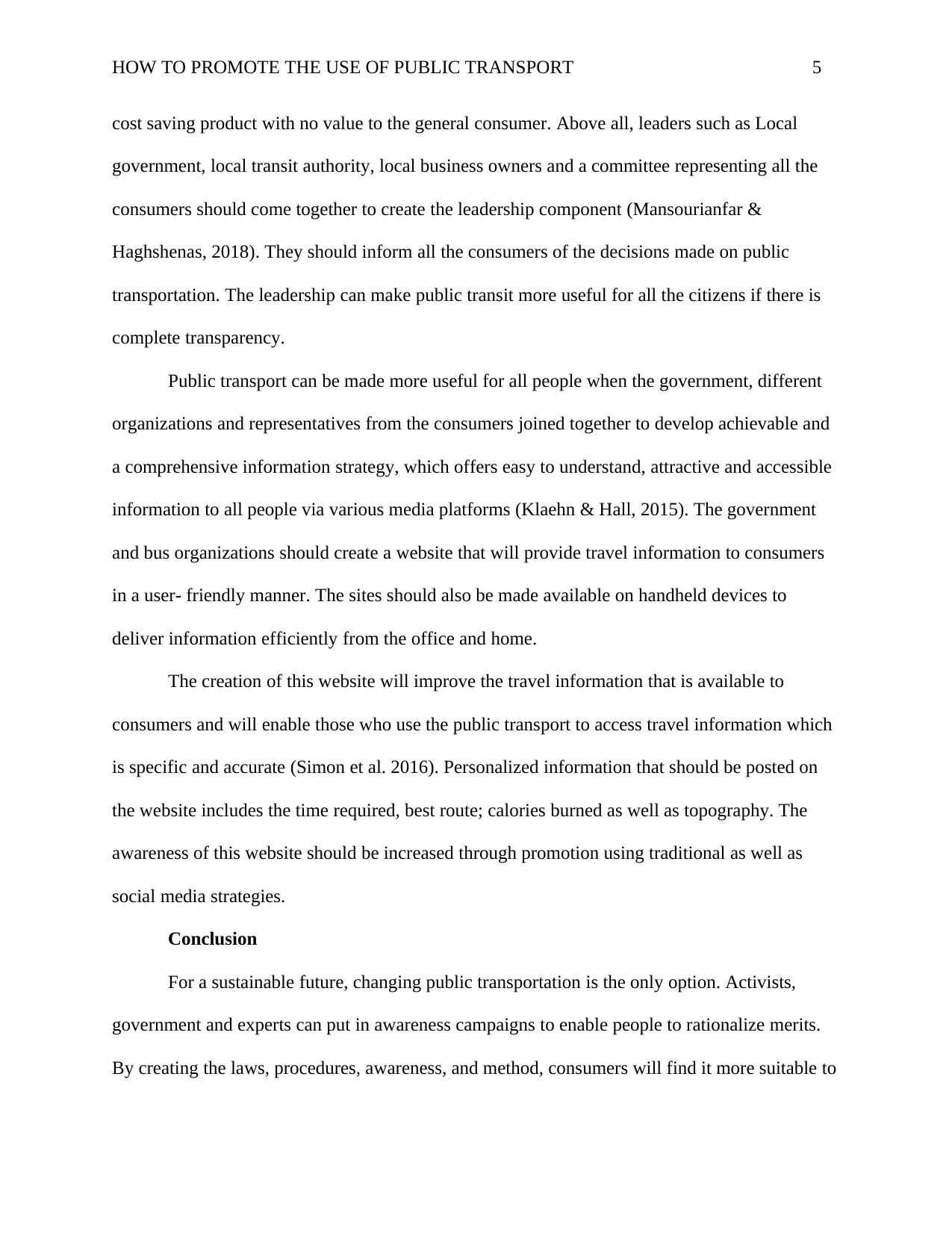
HOW TO PROMOTE THE USE OF PUBLIC TRANSPORT 5
cost saving product with no value to the general consumer. Above all, leaders such as Local
government, local transit authority, local business owners and a committee representing all the
consumers should come together to create the leadership component (Mansourianfar &
Haghshenas, 2018). They should inform all the consumers of the decisions made on public
transportation. The leadership can make public transit more useful for all the citizens if there is
complete transparency.
Public transport can be made more useful for all people when the government, different
organizations and representatives from the consumers joined together to develop achievable and
a comprehensive information strategy, which offers easy to understand, attractive and accessible
information to all people via various media platforms (Klaehn & Hall, 2015). The government
and bus organizations should create a website that will provide travel information to consumers
in a user- friendly manner. The sites should also be made available on handheld devices to
deliver information efficiently from the office and home.
The creation of this website will improve the travel information that is available to
consumers and will enable those who use the public transport to access travel information which
is specific and accurate (Simon et al. 2016). Personalized information that should be posted on
the website includes the time required, best route; calories burned as well as topography. The
awareness of this website should be increased through promotion using traditional as well as
social media strategies.
Conclusion
For a sustainable future, changing public transportation is the only option. Activists,
government and experts can put in awareness campaigns to enable people to rationalize merits.
By creating the laws, procedures, awareness, and method, consumers will find it more suitable to
cost saving product with no value to the general consumer. Above all, leaders such as Local
government, local transit authority, local business owners and a committee representing all the
consumers should come together to create the leadership component (Mansourianfar &
Haghshenas, 2018). They should inform all the consumers of the decisions made on public
transportation. The leadership can make public transit more useful for all the citizens if there is
complete transparency.
Public transport can be made more useful for all people when the government, different
organizations and representatives from the consumers joined together to develop achievable and
a comprehensive information strategy, which offers easy to understand, attractive and accessible
information to all people via various media platforms (Klaehn & Hall, 2015). The government
and bus organizations should create a website that will provide travel information to consumers
in a user- friendly manner. The sites should also be made available on handheld devices to
deliver information efficiently from the office and home.
The creation of this website will improve the travel information that is available to
consumers and will enable those who use the public transport to access travel information which
is specific and accurate (Simon et al. 2016). Personalized information that should be posted on
the website includes the time required, best route; calories burned as well as topography. The
awareness of this website should be increased through promotion using traditional as well as
social media strategies.
Conclusion
For a sustainable future, changing public transportation is the only option. Activists,
government and experts can put in awareness campaigns to enable people to rationalize merits.
By creating the laws, procedures, awareness, and method, consumers will find it more suitable to
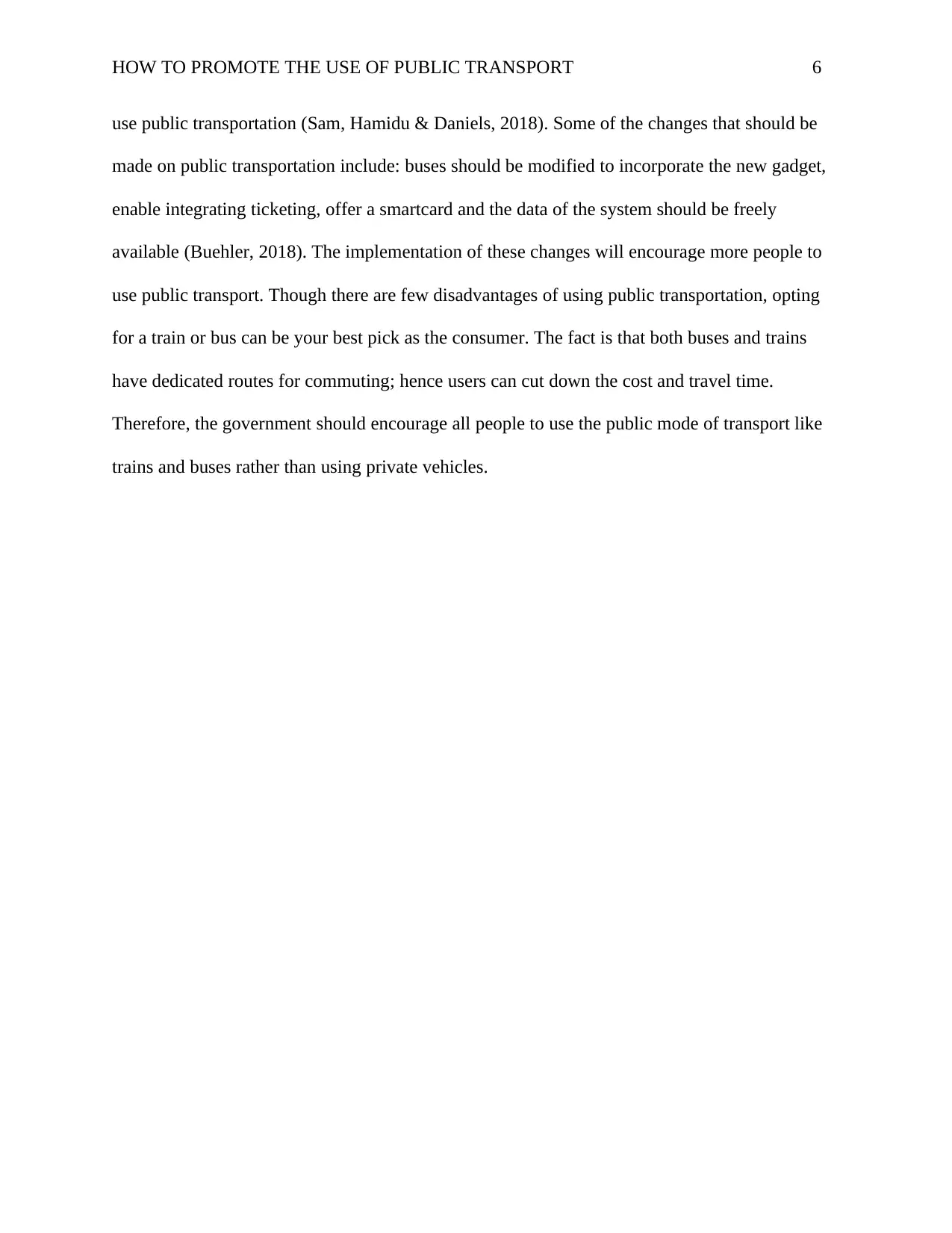
HOW TO PROMOTE THE USE OF PUBLIC TRANSPORT 6
use public transportation (Sam, Hamidu & Daniels, 2018). Some of the changes that should be
made on public transportation include: buses should be modified to incorporate the new gadget,
enable integrating ticketing, offer a smartcard and the data of the system should be freely
available (Buehler, 2018). The implementation of these changes will encourage more people to
use public transport. Though there are few disadvantages of using public transportation, opting
for a train or bus can be your best pick as the consumer. The fact is that both buses and trains
have dedicated routes for commuting; hence users can cut down the cost and travel time.
Therefore, the government should encourage all people to use the public mode of transport like
trains and buses rather than using private vehicles.
use public transportation (Sam, Hamidu & Daniels, 2018). Some of the changes that should be
made on public transportation include: buses should be modified to incorporate the new gadget,
enable integrating ticketing, offer a smartcard and the data of the system should be freely
available (Buehler, 2018). The implementation of these changes will encourage more people to
use public transport. Though there are few disadvantages of using public transportation, opting
for a train or bus can be your best pick as the consumer. The fact is that both buses and trains
have dedicated routes for commuting; hence users can cut down the cost and travel time.
Therefore, the government should encourage all people to use the public mode of transport like
trains and buses rather than using private vehicles.
⊘ This is a preview!⊘
Do you want full access?
Subscribe today to unlock all pages.

Trusted by 1+ million students worldwide
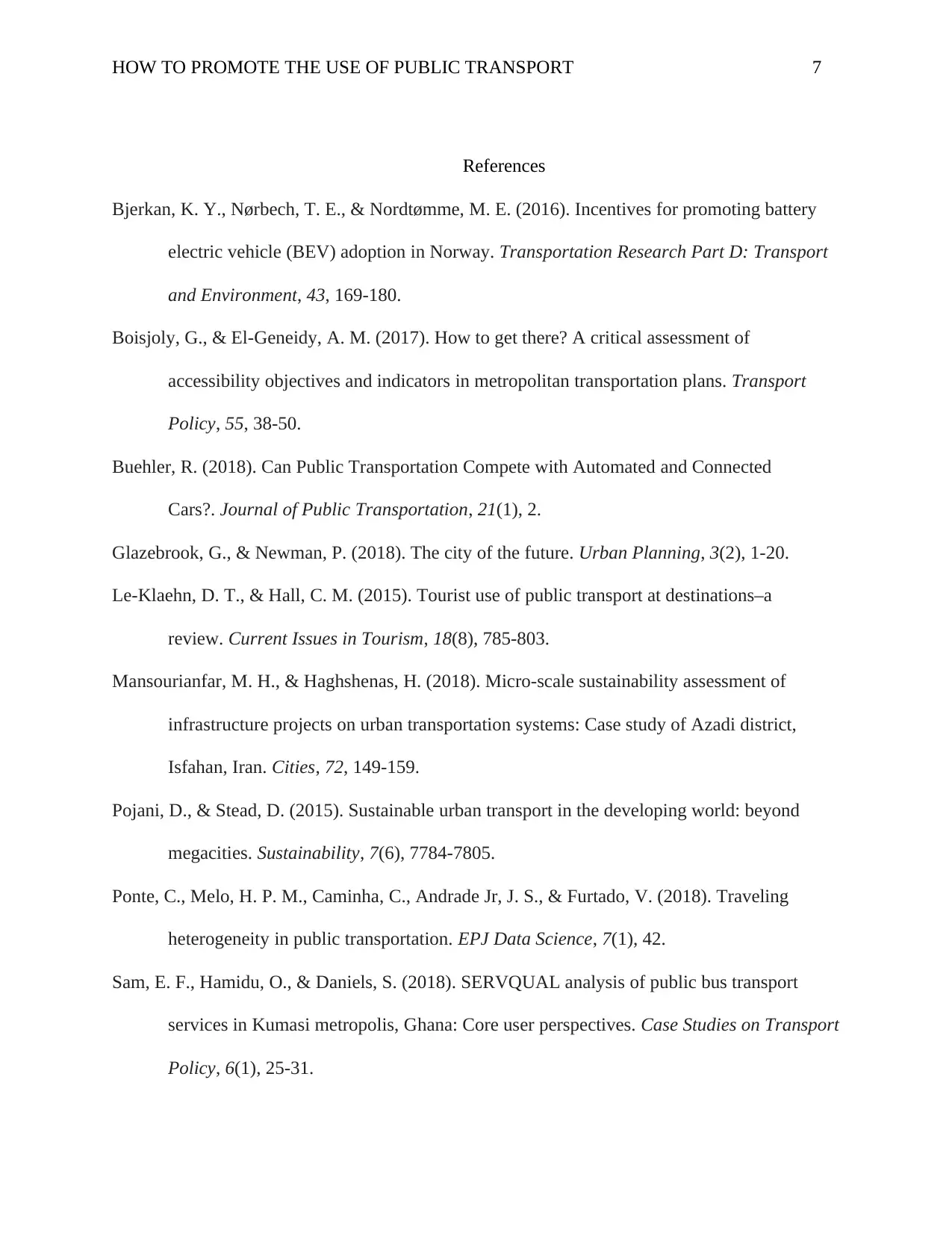
HOW TO PROMOTE THE USE OF PUBLIC TRANSPORT 7
References
Bjerkan, K. Y., Nørbech, T. E., & Nordtømme, M. E. (2016). Incentives for promoting battery
electric vehicle (BEV) adoption in Norway. Transportation Research Part D: Transport
and Environment, 43, 169-180.
Boisjoly, G., & El-Geneidy, A. M. (2017). How to get there? A critical assessment of
accessibility objectives and indicators in metropolitan transportation plans. Transport
Policy, 55, 38-50.
Buehler, R. (2018). Can Public Transportation Compete with Automated and Connected
Cars?. Journal of Public Transportation, 21(1), 2.
Glazebrook, G., & Newman, P. (2018). The city of the future. Urban Planning, 3(2), 1-20.
Le-Klaehn, D. T., & Hall, C. M. (2015). Tourist use of public transport at destinations–a
review. Current Issues in Tourism, 18(8), 785-803.
Mansourianfar, M. H., & Haghshenas, H. (2018). Micro-scale sustainability assessment of
infrastructure projects on urban transportation systems: Case study of Azadi district,
Isfahan, Iran. Cities, 72, 149-159.
Pojani, D., & Stead, D. (2015). Sustainable urban transport in the developing world: beyond
megacities. Sustainability, 7(6), 7784-7805.
Ponte, C., Melo, H. P. M., Caminha, C., Andrade Jr, J. S., & Furtado, V. (2018). Traveling
heterogeneity in public transportation. EPJ Data Science, 7(1), 42.
Sam, E. F., Hamidu, O., & Daniels, S. (2018). SERVQUAL analysis of public bus transport
services in Kumasi metropolis, Ghana: Core user perspectives. Case Studies on Transport
Policy, 6(1), 25-31.
References
Bjerkan, K. Y., Nørbech, T. E., & Nordtømme, M. E. (2016). Incentives for promoting battery
electric vehicle (BEV) adoption in Norway. Transportation Research Part D: Transport
and Environment, 43, 169-180.
Boisjoly, G., & El-Geneidy, A. M. (2017). How to get there? A critical assessment of
accessibility objectives and indicators in metropolitan transportation plans. Transport
Policy, 55, 38-50.
Buehler, R. (2018). Can Public Transportation Compete with Automated and Connected
Cars?. Journal of Public Transportation, 21(1), 2.
Glazebrook, G., & Newman, P. (2018). The city of the future. Urban Planning, 3(2), 1-20.
Le-Klaehn, D. T., & Hall, C. M. (2015). Tourist use of public transport at destinations–a
review. Current Issues in Tourism, 18(8), 785-803.
Mansourianfar, M. H., & Haghshenas, H. (2018). Micro-scale sustainability assessment of
infrastructure projects on urban transportation systems: Case study of Azadi district,
Isfahan, Iran. Cities, 72, 149-159.
Pojani, D., & Stead, D. (2015). Sustainable urban transport in the developing world: beyond
megacities. Sustainability, 7(6), 7784-7805.
Ponte, C., Melo, H. P. M., Caminha, C., Andrade Jr, J. S., & Furtado, V. (2018). Traveling
heterogeneity in public transportation. EPJ Data Science, 7(1), 42.
Sam, E. F., Hamidu, O., & Daniels, S. (2018). SERVQUAL analysis of public bus transport
services in Kumasi metropolis, Ghana: Core user perspectives. Case Studies on Transport
Policy, 6(1), 25-31.
Paraphrase This Document
Need a fresh take? Get an instant paraphrase of this document with our AI Paraphraser
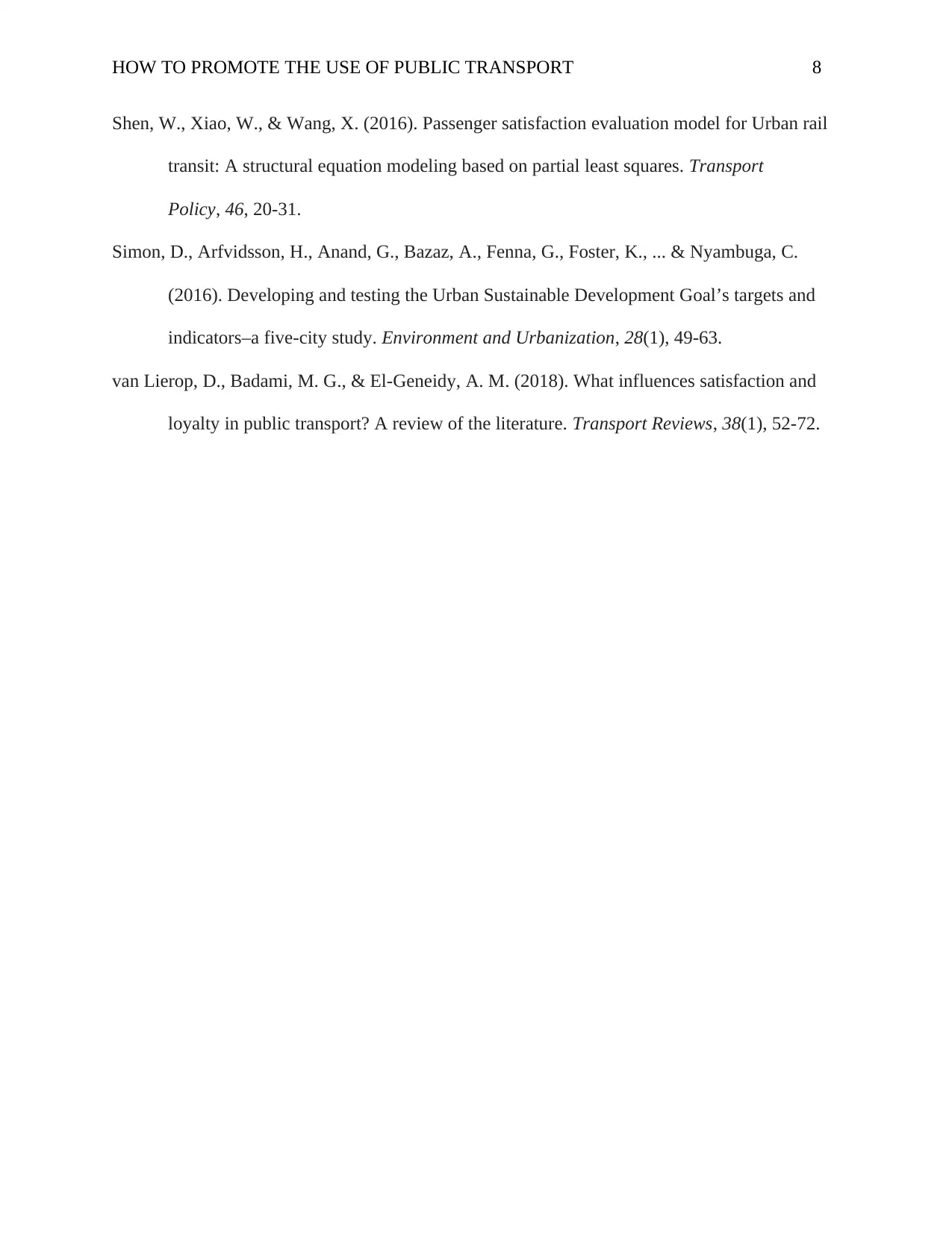
HOW TO PROMOTE THE USE OF PUBLIC TRANSPORT 8
Shen, W., Xiao, W., & Wang, X. (2016). Passenger satisfaction evaluation model for Urban rail
transit: A structural equation modeling based on partial least squares. Transport
Policy, 46, 20-31.
Simon, D., Arfvidsson, H., Anand, G., Bazaz, A., Fenna, G., Foster, K., ... & Nyambuga, C.
(2016). Developing and testing the Urban Sustainable Development Goal’s targets and
indicators–a five-city study. Environment and Urbanization, 28(1), 49-63.
van Lierop, D., Badami, M. G., & El-Geneidy, A. M. (2018). What influences satisfaction and
loyalty in public transport? A review of the literature. Transport Reviews, 38(1), 52-72.
Shen, W., Xiao, W., & Wang, X. (2016). Passenger satisfaction evaluation model for Urban rail
transit: A structural equation modeling based on partial least squares. Transport
Policy, 46, 20-31.
Simon, D., Arfvidsson, H., Anand, G., Bazaz, A., Fenna, G., Foster, K., ... & Nyambuga, C.
(2016). Developing and testing the Urban Sustainable Development Goal’s targets and
indicators–a five-city study. Environment and Urbanization, 28(1), 49-63.
van Lierop, D., Badami, M. G., & El-Geneidy, A. M. (2018). What influences satisfaction and
loyalty in public transport? A review of the literature. Transport Reviews, 38(1), 52-72.
1 out of 8
Related Documents
Your All-in-One AI-Powered Toolkit for Academic Success.
+13062052269
info@desklib.com
Available 24*7 on WhatsApp / Email
![[object Object]](/_next/static/media/star-bottom.7253800d.svg)
Unlock your academic potential
Copyright © 2020–2025 A2Z Services. All Rights Reserved. Developed and managed by ZUCOL.





